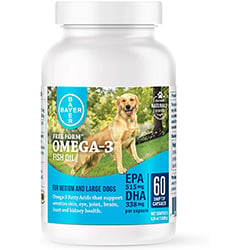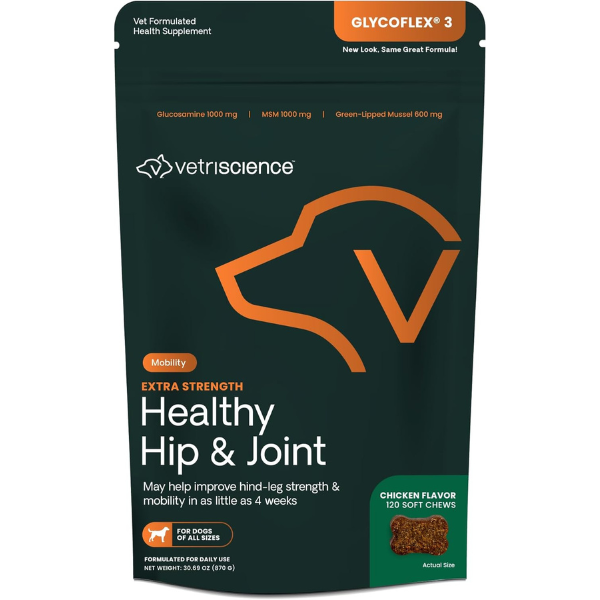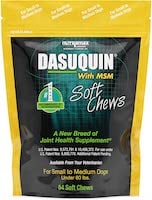 Nobody wants to see their dog suffering and in pain. Sometimes, it can be very difficult to know for sure whether or not your dog is in pain.
Nobody wants to see their dog suffering and in pain. Sometimes, it can be very difficult to know for sure whether or not your dog is in pain.
Sure, sometimes it’s quite obvious — a noticeable limp, large cut, or observed trauma, such as being struck by a car.
But other times, your dog’s signs of pain can be far more subtle.
It’s at these times that people often need guidance on what to look for to know if their dog is in pain.
Signs That Could Indicate Pain in Dogs
Some dogs can be quite stoic and do a good (though detrimental) job of hiding and “living with” their pain. But that’s not what we want for our dogs, right? Fortunately, there are lots of signs you can look for that might indicate your dog is experiencing pain.
As with many other aspects of caring for your dog, these signs will be more obvious to you (even when they are subtle) if you have a good idea of your dog’s “normal.” This includes his normal attitude, energy level, gait, appetite, thirst, sleep patterns, and other physical and behavioral patterns. After all, if you don’t know what’s “normal,” it’s much more difficult to recognize what’s not.
Important note: When evaluating your dog for potential pain, please take great care to not get yourself (or anyone helping you) bitten. Even if your dog would never normally bite anyone, the mere fact that you’re evaluating your dog for pain indicates that this may not be a normal time. This brings me nicely to the first sign I’d like to discuss …
Five Dog Pain Tips:
Symptoms of pain can be subtle and easy to miss.Dogs in pain are more likely to bite — be careful!
Behavior, breathing, heart rate, and even appearance can all change when your dog is experiencing pain.
If your dog is in pain, call your vet.
Never give medication to your dog unless instructed to do so by your veterinarian.
Biting or Snapping
Dogs in pain are more likely to bite. This is true even with their owners and other people they know. This is particularly true when a person touches or moves the painful area. Some dogs will guard certain parts of their body that are hurting and air snap if they think that someone is reaching to touch that area.
For example, if your dog's ear is hurting due to an infection, they might snap or bite if you reach to scratch them behind that ear or even if you (or someone else) just extend a hand to pet their head.
Breathing Changes
Dogs experiencing pain may have a faster and more shallow breathing pattern than normal. They may also pant. You may even notice a change in the movement of the abdominal muscles and/or those of the chest. Both sets of muscles are involved in the breathing process.
Heart and Pulse Changes
Dogs in pain will often have an increased heart/pulse rate. The rate often noticeably speeds up when the painful area is touched or moved. Take a pet first-aid course, ask your veterinarian or one of the clinic technicians to show you how to check and measure your dog’s heart and/or pulse rate, or check out this video that explains how to check your pet's vital signs:
Posture Changes
Dogs who are in pain may assume a very rigid, “sawhorse-type” stance, while others may assume the “prayer position” with their front legs on the ground, their butt up in the air, and a stretch throughout their abdomen. It looks like a “play bow,” but it is anything but playful.
Some dogs in pain will lie around more, while others will be more “antsy” and have difficulty lying down and getting comfortable. It all depends on the type, location, and severity of the pain.
These postural changes can be even more subtle, taking the shape of an arched or sunken back or even a dropped or tucked tail in a dog who normally has a perky tail.
Eye Changes
The eyes can be great indicators of pain in dogs. They change both for eye pain itself and for pain elsewhere in the body. Often, pain elsewhere in the body will result in larger (dilated) pupils, while pain in the eye(s) can result in either larger or smaller (constricted) pupils – depending on the underlying injury or disease process and whether one or both eyes are affected.
Dogs in pain will also frequently squint and may also paw at their eye(s) or drag them along the carpet or furniture. If their eyes are in pain, the affected eye(s) may also appear bloodshot.
PRO TIP: Foxtails (a.k.a., grass seed awns) are a common cause of eye pain in dogs at certain times of the year.

Food and Water Changes
Dogs in pain often eat and drink less than normal. When they do eat and drink, if the cause of their pain is their teeth or some other part of the mouth, they may drop food and/or water from their mouth.
Energy Level Changes
Most dogs in pain will have a general decrease in their activity level. This often shows as a dog who sleeps more. It may also manifest as a dog who simply runs and/or jumps less than normal.
PRO TIP: A wearable activity monitor, like the Whistle Pet Health & Location Tracker or the Fitbark 2 Activity Monitor, can help you detect problems early by allowing you to see and track changes in your dog's behavior and activity levels.
If such changes are noticed and they persist, or are accompanied by other concerning signs, then you'll know that it's time to head to the vet for a checkup and to see if your dog may be in pain.
Mobility Changes
Dogs in pain often move around less. However, depending on what hurts, they may still move around the same amount but do so differently (i.e., with a limp or more slowly when going up or down the stairs).
For dogs that are having difficulty with stairs due to leg/paw pain, it's usually the case that those having trouble going UP the stairs have pain in their backend (e.g., hip, knee, paw, etc.), while those that have trouble going DOWN have a problem with their front end (e.g., shoulder, elbow, paw, etc.)
PRO TIP: It can help to take video of your dog with mobility problems walking or running, especially if you shoot the video in slo-mo, in good light, and with the camera/phone in landscape (horizontal) positioning.
Sometimes such videos can be help your vet begin to figure out where your dog's pain is originating from.
Bathroom Changes
Dogs who have back pain, for any reason, may have difficulty with the posture needed to defecate. So they may struggle to go to the bathroom. Sometimes, dogs with back pain can even become constipated in the process — though pain itself can also lead to slowed motility of the intestines and thus lead directly to constipation, too.
Male dogs with back pain may also change their "peeing posture" due to either back or back leg pain, as it can be more difficult or painful for them to lift their leg to assume the typical male dog peeing posture.
Body Contour Changes
Swelling, be it on your dog’s legs, body, or face, can be an indication of a painful condition, such as infection, inflammation, cancer, or others.
For example, a swelling on the top of your dog's muzzle or underside of their jaw, or even swelling around one of their eyes, can be an indication of a tooth root abscess. A painful condition that many dogs will still normally eat through, but still needs veterinary care to address
Conditions That Are Often Painful for Dogs
While it’s quite obvious that a broken bone, gaping wound, or recent surgical procedure will likely be painful to your dog, those aren’t the only causes for pain. Your dog might be a little bit uncomfortable after getting their shots, as those injection sites can be tender from the inflammation an injection and vaccination causes.
If your dog is in pain after grooming, you'll want to check them over for any razor burn or injury to sensitive areas, such as their ears and paw pads. There are lots of other common conditions that cause pain that often go unrecognized by dog owners and, therefore, untreated by their veterinarians.
If your dog has been diagnosed with any of the conditions below, be sure to speak with your veterinarian to make sure that any painful aspect of the condition is being treated properly. In fact, if your dog is diagnosed with any medical condition, it is always a good idea to ask your veterinarian if there is any pain component to the condition and, if so, what options there are for treating that pain.
- Cancer – especially bone cancer, any type of cancer that enlarges a capsular organ (e.g., a kidney or the spleen), and tumors that press on important internal structures.
- Kidney or bladder stones
- Bladder inflammation (“cystitis”)
- Ear infection – these can be very painful for dogs, especially if the infection has been going on for a long time and/or it involves the middle or inner ear. Read about "when NOT to clean your dog's ears."
- Inflammation of the pancreas (“pancreatitis”) and/or the stomach (“gastritis”) and intestines (“enteritis”)
- Inflammation of a joint (“arthritis”) – this could be the hip(s), elbow(s), or any other joint(s)
- See below for some recommended supplements that could help dogs with the pain and inflammation of arthritis.
- Infected, impacted, or ruptured anal glands
- Cruciate ligament damage or “sliding knee cap” (“patellar luxation”)
- “Slipped disc(s)” (Intervertebral disc disease or IVDD for short)
- Periodontal disease or tooth fracture
- Eye problems such as glaucoma, uveitis, or corneal ulcers

It’s important to speak with or see your veterinarian any time your dog is in pain, or if you think they may be. Not only is it important so that the underlying cause of the pain can be determined and appropriately treated and managed, but also because many pet owners have inadvertently caused toxicity or further injury to their dog by self-prescribing medications without first checking with their veterinarian.
Read this article about how one physician used to treating people, almost killed her own dog, and then learn more about the dangers of human medications in pets.
Supplements and Other Ways to Help Dogs With Arthritis
First, it needs to be repeated that you should never give your dog human pain medications (even aspirin or "doggie aspirin") — nor should you give them another dog's prescription pain medications unless explicitly told to do so by your vet. But that doesn't mean you can't do anything for your dog if you're concerned that they're suffering from arthritis.
Fish oils contain Omega-3 fatty acids, which have anti-inflammatory properties that can help to minimize and relieve joint pain. There are also specific joint supplements that can help dogs with arthritis, as well as some specially formulated diets for joint pain.
Check out our recommended fish oil and joint supplement brands below, as well as some of the prescription joint-health diets to check with your veterinarian about.
Fish Oils
Fish oils can help to minimize the inflammation and, therefore, pain associated with arthritis. They're not necessarily a "magic bullet" or singular therapy for dogs suffering from arthritis, but they can be a good part of a multi-pronged approach to pain management.
Fish oils can have the added benefit of helping with skin/coat conditions, kidney disease, canine cognitive dysfunction ("doggie dementia"), and possibly other conditions, too. The two important Omega-3 fatty acids in fish oils are abbreviated EPA and DHA.
You can use "human" fish oils for your dog; just be careful. When selecting a fish oil for your dog, read the label carefully and make sure it does not contain xylitol, a natural sugar substitute that is fine for people but highly toxic to dogs.
The fish oils listed below are three of the best brands and formulations that I've found and used for dogs. The size of your dog, as well as the formulation (e.g., liquid or capsules) you want to administer, will help determine which one is best for your situation.
Liquid formulations make for easy dosing, but you can also cut off the top of capsules and squirt the fish oil liquid onto your dog's food.
Blood Protein Supplements
Supplements that use blood proteins that are rich in immunoglobulins may help reduce inflammation, promote healing, and provide other benefits for dogs. The WINPRO line of supplements (Immunity, Mobility, Allergy, Focus, Training) has been met with very positive feedback from dog owners. In our own experience, our dogs loved the taste of them.
You only give your dog one or two (depending on their weight) each day, so a bag of 60 will last you 1-2 months. You should not give your dog more than the recommended amount.
Joint Supplements for Dogs
The arthritic support joint supplements recommended below are all made by reputable and reliable companies within the animal health field, and have all been used successfully to manage arthritis in many dogs. Every dog and every situation is different, so it's tough to say which one any particular dog will respond best to.
However, given the research that the companies have done, as well as the number of dogs that have used these as part of a successful arthritis pain management protocol, starting with one of these supplements is a good first step. Like the fish oils recommended above, it's always best to give a joint supplement for at least a couple of months to know whether it's helping your dog.
Joint Relief and Mobility Diets for Dogs
There are prescription joint/mobility diets specifically formulated to help arthritic dogs. These include Hill’s Metabolic + Mobility and Royal Canin Joint Support dog foods. Speak with your veterinarian to see if such a diet might help your dog.
Increasing Mobility for Dogs
If you have hardwood floors or other slick surfaces in your home, this can worsen pain and mobility issues for an older dog or a dog with arthritis. In addition to treating their pain with the supplements mentioned above, as well as any prescription medications your vet recommends, something as simple as carpet runners, no-slip dog socks, or a set of pet steps can do wonders toward increasing your dog's mobility.
To learn more, check out "How to Help an Older Dog With Arthritis and Other Mobility Problems."
By keeping an eye out for any subtle changes to your dog's behavior and body language, you can address any underlying pain that they might be experiencing. Your veterinarian is your best resource for preventing and treating your dog's pain.
Your dog will have a greater quality of life when their pain is properly managed with medication, supplements, and a comfortable home setup.











